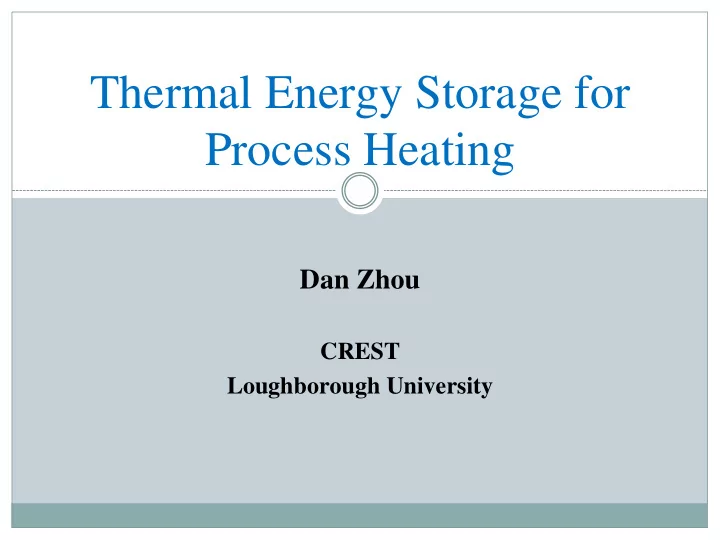

Thermal Energy Storage for Process Heating Dan Zhou CREST Loughborough University
Industrial Process Heat Industrial sector accounts for about 20% of the final user energy demand. Most of the energy comes from fossil fuels directly or indirectly. Heat is responsible for 70% of final energy demand in industry. Among the industrial process heat, about 30% is in the temperature range of 0-200 ° C.
Industrial Process Heat Technologies for recover and re-use the heat : On-site heat recovery Upgrading the heat for use at a higher temperature Conversion of surplus heat to chilling energy Conversion of heat to electricity The transportation of heat to meet an offsite heat demand. Problem: Discrepancy between the heat supply and heat demand.
Thermal Energy Storage Sensible heat storage Latent heat storage (my research): Thermal energy storage with phase change materials (PCMs) is an effective way due to its high heat storage density and its isothermal operating characteristics. Thermochemical storage
My Research Aim: 1. Review the available industrial process heat. 2. Test the materials properties, including melting temperature, latent heat, corrosion and thermal stability. 3. Design a system of thermal energy storage with PCMs at a temperature around 200 ° C. 4. Experimentally study the heat charging and discharging characteristics with different PCMs. 5. Numerically study the heat storage characteristics to optimise the system operation.
My Research Materials Compound Melting temperature Latent heat Thermal Density ° C kJ/kg conductivity Kg/m 3 W/m 2 K LiNO 3 +NaNO 3 193 248 0.57+0.43 LiNO 3 +NaNO 3 194 265 0.49+0.51 LiNO 3 +NaCl 208 369 0.7 2355 0.87+0.13 H190 191 170 0.518 2300
My Research Schematic of the experimental setup
My Research Heat storage container Copper made; Helical coils with fins to enhance the heat transfer rate; Eutectics of LiNO 3 +NaNO 3; Heat transfer fluid: Julabo H350; Charging/ discharging power could be at 3- 4 KW; Charging/ discharging time could be at 2-3 hours.
My Research Timeline for the experiment:
Thank you!
Recommend
More recommend